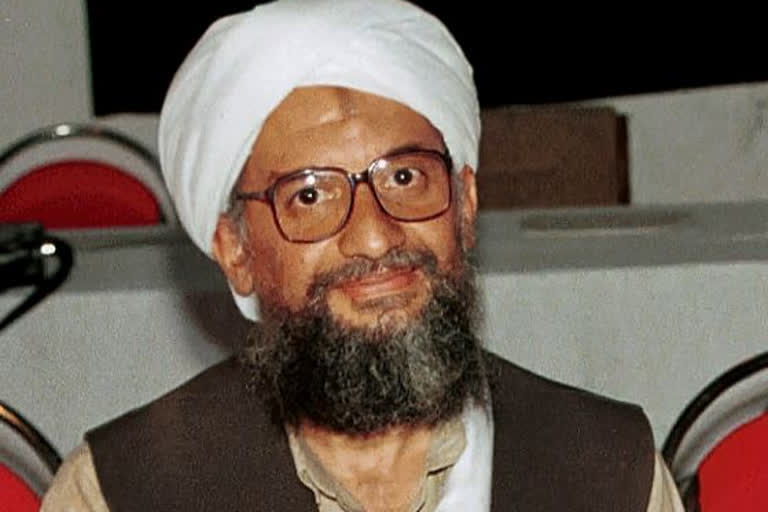New York : Al-Qaeda leader Ayman al-Zawahiri liked to read alone on the balcony of his Kabul safe house early in the morning, a "pattern-of-life intelligence" that eventually gave American intelligence agencies the chance to carry out a precision strike that killed one of the world's most wanted terrorists, a report said. Zawahiri, who played a key role in the 9/11 attacks and later formed Al-Qaeda's regional affiliate in the Indian subcontinent, was killed in a US drone strike on Saturday evening.
"Intelligence officers made a crucial discovery this spring after tracking Ayman al-Zawahri, the leader of Al Qaeda, to Kabul, Afghanistan: He liked to read alone on the balcony of his safe house early in the morning," The New York Times (NYT) said in a report titled 'How the CIA Tracked the Leader of Al Qaeda'. The report said that analysts search for "pattern-of-life intelligence", which means any habit the CIA can exploit to hunt down and target terrorists. "In al-Zawahri's case, his long balcony visits gave the agency an opportunity for a clear missile shot that could avoid collateral damage," it said.
Once intelligence agencies confirmed the location of Zawahiri's safe house, the CIA followed the playbook it wrote during the hunt for (Osama) Bin Laden. The agency built a model of the site and sought to learn everything about it. Analysts eventually identified a figure who lingered on the balcony reading, but never left the house, as al-Zawahiri," the NYT report said.
On July 25, Biden authorised the CIA to conduct the airstrike "when the opportunity presented itself".
Also Read-Explainer: Who was Ayman Al-Zawahiri and why did US kill him?
Sunday morning in Kabul, it did. A drone flown by the CIA found al-Zawahri on his balcony. The agency operatives fired the missile, ending a more than two-decade-long hunt, the report said. US President Joe Biden announced on Monday that Zawahiri, who took over the reins of Al-Qaeda after the killing of Osama bin Laden 11 years ago, was killed in an American drone strike. Biden said "justice has been delivered and this terrorist leader is no more."
The NYT report said that on April 1, top intelligence officials briefed national security officials at the White House about the safe house and how they had tracked Zawahiri. A "key insight" that had emerged about Zawahiri's pattern of life was that "he was never seen leaving the house and only seemed to get fresh air by standing on a balcony on an upper floor. He remained on the balcony for extended periods, which gave the CIA a good chance to target him." The Al-Qaeda leader was killed by a Hellfire missile, which is "designed to kill a single person."
Biden was briefed by CIA director William Burns and other intelligence officials on July 1 and he was shown a model of the safe house. Biden asked about the possibility of collateral damage, prodding" Burns to take him "through the steps of how officers had found al-Zawahri and confirmed his information and their plans to kill him. During June and July, discussions focussed on intelligence and examining the potential ramifications of the strike. The report added that the "safe house" where Zawahiri stayed was owned by "an aide to senior officials in the Haqqani network" in an area in the Afghan capital controlled by the terror group.
Senior Taliban leaders occasionally met at the house, but American officials do not know how many knew that the Haqqanis were hiding al-Zawahri. If some senior Taliban officials did not know that the Haqqanis had allowed al-Zawahri to return, his killing could drive a wedge between the groups," the report said citing independent analysts. It added that Zawahiri's ties to leaders of the Haqqani network "led US intelligence officials to the safe house" where he was hiding. For many years, it was believed that Zawahiri was hiding in the border area of Pakistan and it remains unclear why he returned to Afghanistan, the report said. Following the withdrawal of US troops from Afghanistan, it is believed that Zawahiri's family returned to a safe house in Kabul.
The NYT report said that while his family tried to ensure they were not being watched and keep Zawahiri's location secret, "intelligence agencies soon learned he too had returned to Afghanistan. There was a renewed effort to figure out where he was," the report quoted former CIA officer Mick Mulroy as saying. "The one good thing that might have come out of withdrawing from Afghanistan is that certain high-level terrorist figures would then think it is safe for them to be there. PTI



